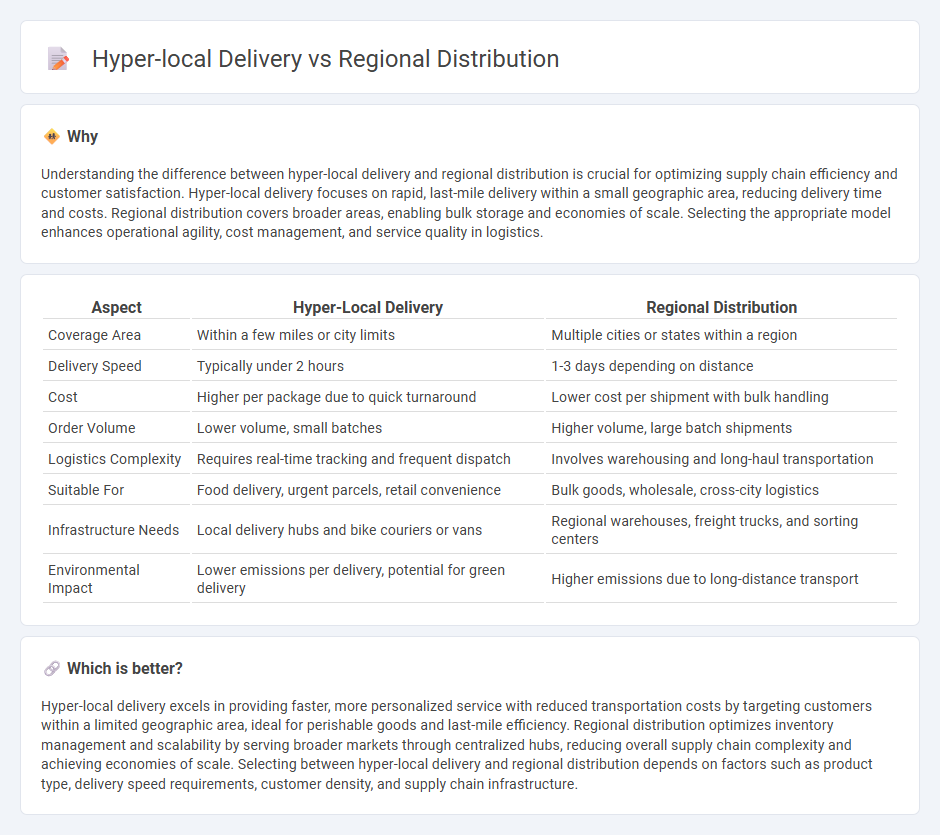
Hyper-local delivery focuses on rapid shipping within a small geographic area, leveraging localized warehouses and real-time routing to enhance customer convenience and speed. Regional distribution covers broader territories, optimizing inventory management and transportation networks to serve multiple cities or states efficiently. Explore the advantages and challenges of both models to determine the best fit for your supply chain needs.
Why it is important
Understanding the difference between hyper-local delivery and regional distribution is crucial for optimizing supply chain efficiency and customer satisfaction. Hyper-local delivery focuses on rapid, last-mile delivery within a small geographic area, reducing delivery time and costs. Regional distribution covers broader areas, enabling bulk storage and economies of scale. Selecting the appropriate model enhances operational agility, cost management, and service quality in logistics.
Comparison Table
| Aspect | Hyper-Local Delivery | Regional Distribution |
|---|---|---|
| Coverage Area | Within a few miles or city limits | Multiple cities or states within a region |
| Delivery Speed | Typically under 2 hours | 1-3 days depending on distance |
| Cost | Higher per package due to quick turnaround | Lower cost per shipment with bulk handling |
| Order Volume | Lower volume, small batches | Higher volume, large batch shipments |
| Logistics Complexity | Requires real-time tracking and frequent dispatch | Involves warehousing and long-haul transportation |
| Suitable For | Food delivery, urgent parcels, retail convenience | Bulk goods, wholesale, cross-city logistics |
| Infrastructure Needs | Local delivery hubs and bike couriers or vans | Regional warehouses, freight trucks, and sorting centers |
| Environmental Impact | Lower emissions per delivery, potential for green delivery | Higher emissions due to long-distance transport |
Which is better?
Hyper-local delivery excels in providing faster, more personalized service with reduced transportation costs by targeting customers within a limited geographic area, ideal for perishable goods and last-mile efficiency. Regional distribution optimizes inventory management and scalability by serving broader markets through centralized hubs, reducing overall supply chain complexity and achieving economies of scale. Selecting between hyper-local delivery and regional distribution depends on factors such as product type, delivery speed requirements, customer density, and supply chain infrastructure.
Connection
Hyper-local delivery depends on regional distribution networks to ensure rapid fulfillment of customer orders within specific neighborhoods or cities. Efficient regional distribution centers act as strategic hubs that reduce last-mile delivery times and optimize inventory management for hyper-local services. Integration of both systems enhances supply chain agility, lowers transportation costs, and improves overall customer satisfaction.
Key Terms
**Regional Distribution:**
Regional distribution centers streamline supply chain operations by centralizing inventory management across a specific geographic area, enhancing efficiency and reducing transportation costs. These centers enable faster replenishment of retail stores and support bulk shipments, optimizing warehouse utilization and minimizing stockouts. Explore how regional distribution can transform your logistics strategy and improve delivery performance.
Fulfillment Centers
Fulfillment centers are strategically positioned to optimize regional distribution by consolidating inventory and managing bulk shipments efficiently across wide geographic areas. In contrast, hyper-local delivery leverages smaller, closer fulfillment facilities or micro-fulfillment centers to enable rapid delivery within a limited radius, enhancing customer convenience and reducing last-mile costs. Explore more about how fulfillment center strategies can transform your supply chain and delivery operations.
Transportation Hubs
Regional distribution centers optimize transportation hubs by consolidating shipments for wide-area coverage, reducing overall transit times and logistics costs. Hyper-local delivery leverages proximity to customers near transportation hubs, enabling rapid last-mile fulfillment and enhanced service reliability in urban zones. Explore how strategic placement of hubs revolutionizes supply chains and customer satisfaction.
Source and External Links
Regional vs. Centralized Distribution: Evaluating ... - Regional distribution involves strategically located centers near target markets to enable faster deliveries within specific regions and can lead to challenges in inventory management compared to centralized distribution.
What is Regional Distribution Center (RDC)? - A regional distribution center is a warehouse placed strategically within a region to distribute goods efficiently to stores or customers in that area.
Regional Distributors - Regional Distributors, a division of Imperial Dade, is a leading independent distributor in North America providing various supply products with a focus on service beyond expectations and operational optimization.
 dowidth.com
dowidth.com